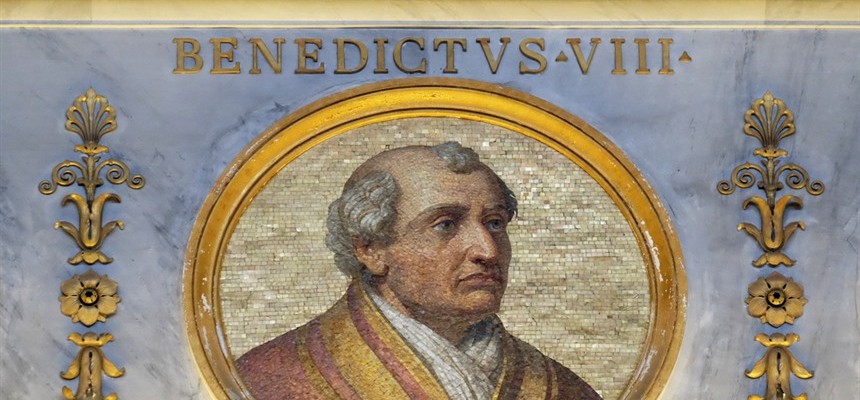
This, in some ways is the story of two families who used to be close, but over the generations, grew to hate each other. You may remember Theophylact, the Roman dictator, who married Theodora, a member of the Crescenti family. Their daughter, Marozia, became a dictator in her own right and it continued down throughout the 900s.
Gregory of Tusculum was the grandson of Marozia. He was the confidante of popes. He lead a rebellion against Emperor Otto III and expelled the Crescentii, his shirttail relations, in 1002. He then became the “Head of the Republic”. But he lost the title when the Crescentii regained power shortly after. He died before 1012, leaving riches and a virtual army to his three children Theophylact, Alberic and Romanus.
Pope Sergius died in June of 1012. Theophylact, a layman, was nominated pope, taking the name Benedict VIII. At virtually the same time, a man named Gregory was nominated by a small group, likely the Crescentii, and determined that he was pope. Theophylact aroused his family army and chased the remaining Crescentii into the mountains, virtually crushing the opposition. Gregory ran to King Henry of Germany, asking for a judgement. Henry took away the papal insignia he was wearing and told him to stop acting like pope while he considered the situation. Gregory was never heard from again.
A year later, King Henry marched into Rome, where Pope Benedict crowned him Holy Roman Emperor, filling the seat left empty by Emperor Otto III’s death twelve years before. Henry and Benedict remained on good terms until their deaths. Shortly after, Henry asked Benedict to include the Nicene Creed in the Mass, something that had not been done in all the years since the Council of Nicaea. Benedict officially added the word “filoque”, meaning that the Holy Spirit proceeds from the Father and the Son. This was to prove equality among the three Persons of the Trinity. The East was offended that the West altered the Creed without a council.
Benedict had his hands full with international problems. He encouraged the “Truce of God”, a peace movement of the Middle Ages. The Saracens again were attacking the west coast of the Italian peninsula. The Byzantine empire decided to retake southern Italy. Benedict, not a trained churchman, used armies to his advantage. He allowed Norman freebooters, pirates, to defeat the Saracens. By 1020, Benedict went to Germany to confer with Henry about the Saracens. While there, he consecrated the new cathedral of Banburg at Easter and he visited the monastery at Fulda. Henry gave him a charter confirming the donations of Charlemagne and Otto I. The emperor led an expedition to southern Italy to subordinate the vassals who had defected to Byzantine authority.
Two years later, Henry and Benedict jointly held a synod at Pavia. The purpose was to restrain simony (the selling of church offices or roles or sacred items) and incontinence (excess, especially of a sexual nature) in the clergy. Reformation of monasteries had begun at the Cluny abbey. Benedict supported the concept. St. Odilo, the abbot of Cluny, was a friend of his.
Pope Benedict VIII died 9 April 1024. He was succeeded by his brother Romanus, who took the name Pope John XIX. Emperor Henry died 12 July the same year. He had no heirs. The Holy Roman Empire reverted to a Frank.
Benedict had his hands full with international problems. He encouraged the “Truce of God”, a peace movement of the Middle Ages. The Saracens again were attacking the west coast of the Italian peninsula. The Byzantine empire decided to retake southern Italy. Benedict, not a trained churchman, used armies to his advantage. He allowed Norman freebooters, pirates, to defeat the Saracens. By 1020, Benedict went to Germany to confer with Henry about the Saracens. While there, he consecrated the new cathedral of Banburg at Easter and he visited the monastery at Fulda. Henry gave him a charter confirming the donations of Charlemagne and Otto I. The emperor led an expedition to southern Italy to subordinate the vassals who had defected to Byzantine authority.
Two years later, Henry and Benedict jointly held a synod at Pavia. The purpose was to restrain simony (the selling of church offices or roles or sacred items) and incontinence (excess, especially of a sexual nature) in the clergy. Reformation of monasteries had begun at the Cluny abbey. Benedict supported the concept. St. Odilo, the abbot of Cluny, was a friend of his.
Pope Benedict VIII died 9 April 1024. He was succeeded by his brother Romanus, who took the name Pope John XIX. Emperor Henry died 12 July the same year. He had no heirs. The Holy Roman Empire reverted to a Frank.

Recent Comments